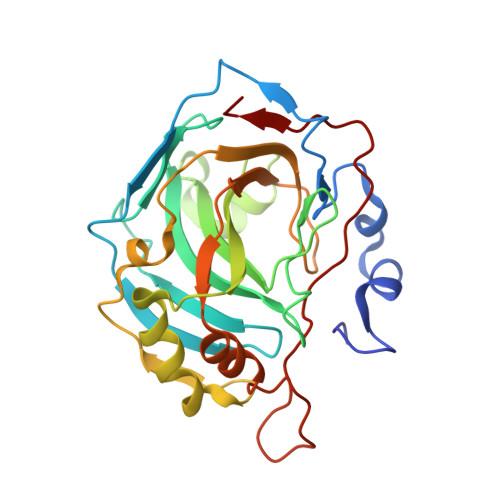Neutron structure of human carbonic anhydrase II in complex with methazolamide: mapping the solvent and hydrogen-bonding patterns of an effective clinical drug.
Aggarwal, M., Kovalevsky, A.Y., Velazquez, H., Fisher, S.Z., Smith, J.C., McKenna, R.(2016) IUCrJ 3: 319-325
- PubMed: 28461893
- DOI: https://doi.org/10.1107/S2052252516010514
- Primary Citation of Related Structures:
5C8I - PubMed Abstract:
Carbonic anhydrases (CAs; EC 4.2.1.1) catalyze the interconversion of CO 2 and HCO 3 - , and their inhibitors have long been used as diuretics and as a therapeutic treatment for many disorders such as glaucoma and epilepsy. Acetazolamide (AZM) and methazolamide (MZM, a methyl derivative of AZM) are two of the classical CA inhibitory drugs that have been used clinically for decades. The jointly refined X-ray/neutron structure of MZM in complex with human CA isoform II (hCA II) has been determined to a resolution of 2.2 Å with an R cryst of ∼16.0%. Presented in this article, along with only the second neutron structure of a clinical drug-bound hCA, is an in-depth structural comparison and analyses of differences in hydrogen-bonding network, water-molecule orientation and solvent displacement that take place upon the binding of AZM and MZM in the active site of hCA II. Even though MZM is slightly more hydrophobic and displaces more waters than AZM, the overall binding affinity ( K i ) for both of the drugs against hCA II is similar (∼10 n M ). The plausible reasons behind this finding have also been discussed using molecular dynamics and X-ray crystal structures of hCA II-MZM determined at cryotemperature and room temperature. This study not only allows a direct comparison of the hydrogen bonding, protonation states and solvent orientation/displacement of AZM and MZM, but also shows the significant effect that the methyl derivative has on the solvent organization in the hCA II active site.
Organizational Affiliation:
Biology and Soft Matter Division, Oak Ridge National Laboratory, Oak Ridge, TN 37831, USA.
















